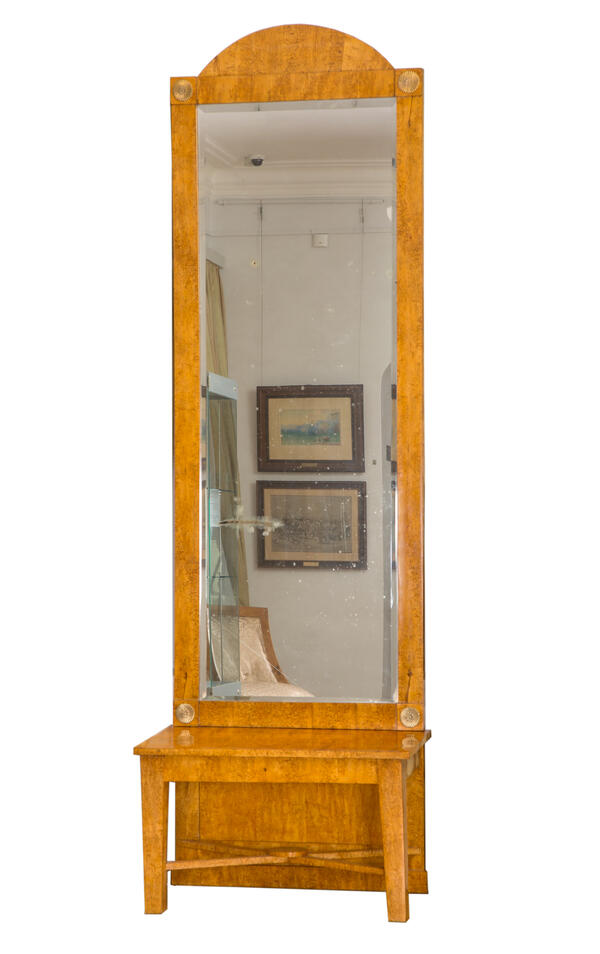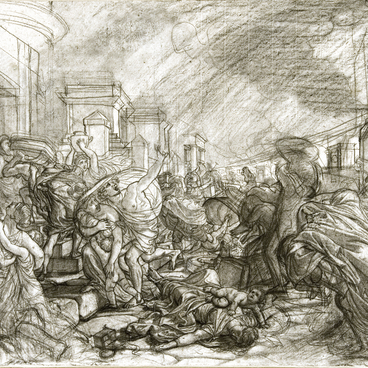The dressing table is part of a furniture set made of Karelian birch, which entered the museum from the Karacharovsky estate of the Counts Uvarov in 1918. Such a large standing mirror was called a “dressing table” from the French word “trumeau”, since initially such mirrors were placed between two window openings. Therefore, the dressing table, like ours, usually has a long and high shape to fit the space. It can be like a suspended mirror attached close to the wall, in which case it sometimes has the same shape and design as the windows themselves. It can also be mounted on a stand in the form of a low cabinet or table, as in this case. Such mirrors have been a common decoration in the reception rooms of classical houses since the XVIII century.
The mirror of Countess Praskovya Sergeevna Uvarova in a rectangular frame has a semi-oval finish and a stand-table. The restorers put the wooden surfaces in order and gave them a shine. Since the end of the XVIII century, Karelian birch wood has been used for the manufacture of expensive furniture, tableware, jewelry boxes. Then it was called the “royal tree”. Palace and manor interiors were furnished with furniture made of unique wood. Unusual birches were discovered in 1766 and first described by the German forester Ferdinand GabrielFokel. On behalf of Catherine II, he explored the forests of the northwestern part of Russia. In appearance, they resembled a simple birch tree, and “the inside was like marble.” Almost a hundred years later (in 1857) Russian scientist and botanistKarl EvgenievichMerklin gave them the name “Karelian birch” because they were first discovered in Karelia.
In most species of other trees, wood from smooth trunks without a flaw is considered ideal. The Karelian birch is quite the opposite. It is an unattractive undersized tree with a severely deformed trunk with spherical swellings and bumps on it. However, it is precisely in the flaws that its true beauty lies — an unusual texture, over the solution of which scientists have been struggling for almost a hundred years. Its surfaces were covered with transparent varnish, emphasizing the intricate pattern of wood. Instead of the annual rings that can be seen on the slices of other trees, the Karelian birch forms a pattern of fancy lines, curls, ticks. Moreover, it is unique on each trunk. Therefore, Russian furniture made of Karelian birch has always stood out for its aristocracy among other furnishings.
The mirror of Countess Praskovya Sergeevna Uvarova in a rectangular frame has a semi-oval finish and a stand-table. The restorers put the wooden surfaces in order and gave them a shine. Since the end of the XVIII century, Karelian birch wood has been used for the manufacture of expensive furniture, tableware, jewelry boxes. Then it was called the “royal tree”. Palace and manor interiors were furnished with furniture made of unique wood. Unusual birches were discovered in 1766 and first described by the German forester Ferdinand GabrielFokel. On behalf of Catherine II, he explored the forests of the northwestern part of Russia. In appearance, they resembled a simple birch tree, and “the inside was like marble.” Almost a hundred years later (in 1857) Russian scientist and botanistKarl EvgenievichMerklin gave them the name “Karelian birch” because they were first discovered in Karelia.
In most species of other trees, wood from smooth trunks without a flaw is considered ideal. The Karelian birch is quite the opposite. It is an unattractive undersized tree with a severely deformed trunk with spherical swellings and bumps on it. However, it is precisely in the flaws that its true beauty lies — an unusual texture, over the solution of which scientists have been struggling for almost a hundred years. Its surfaces were covered with transparent varnish, emphasizing the intricate pattern of wood. Instead of the annual rings that can be seen on the slices of other trees, the Karelian birch forms a pattern of fancy lines, curls, ticks. Moreover, it is unique on each trunk. Therefore, Russian furniture made of Karelian birch has always stood out for its aristocracy among other furnishings.



